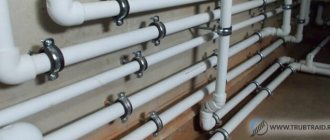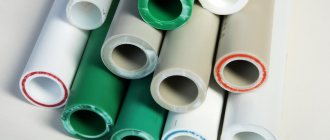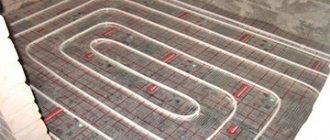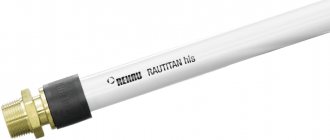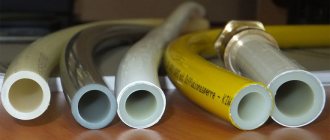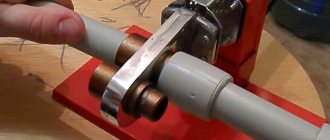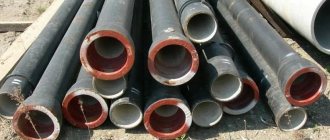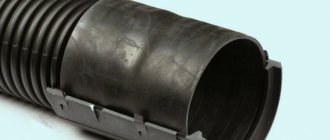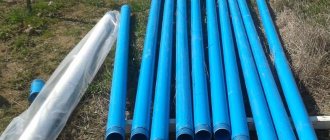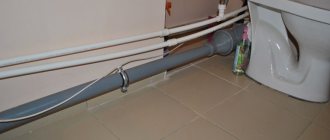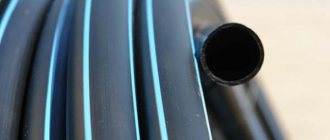Good day, dear reader! Due to its inherent shortcomings, rolled metal pipes have been used less and less in recent decades for wiring the heating systems of private houses and other buildings. Metal-plastic pipes for heating, thanks to the unique structure of the wall, are completely devoid of the weaknesses of metal products. They have anti-corrosion properties, a combination of flexibility with high strength.
Technical characteristics of MP pipes
The general technical characteristics of metal-plastic pipes, regardless of their manufacturer and geometric parameters, are:
- The permissible bending radius using the manual method is in the range from 80 to 550 mm, using a pipe bender - 50-180 mm.
- The maximum pressure level in the pipeline is 10 Bar at an ambient temperature of 95 degrees, 20 Bar at 20 degrees, the destructive pressure will be 80-94 Bar.
- The coefficient of thermal expansion is 0.026 mm/m per 1 ºC.
- Thermal conductivity coefficient is 0.45 W/mK.
Structural properties
MP pipes receive different properties depending on the barrier layer manufacturing technology used:
- Made from sheet aluminum foil. During production, an aluminum billet is welded into a metal-plastic pipe using ultrasonic welding. It is connected to layers of cross-linked polyethylene with adhesive layers. Products reinforced in this way have greater flexibility, but less strength and a small range of permissible operating temperatures.
- In the form of a rigid mesh frame welded from steel wire or strip. The metal frame is poured into the molten plastic of the inner layer, and then filled with molten plastic of the outer layer. With this manufacturing technology, there is no need to use adhesive compounds for gluing layers, which has a positive effect on the strength characteristics of products and the length of their service life.
Working temperature
Metal-plastic pipelines can be used at a constant temperature of the coolant in the heating system up to +95 ºC and for a short time at +110 ºC. Freezing of the working environment begins at -40 ºС.
Life time
Manufacturers usually indicate the service life of metal-plastic pipes for heating at an ambient temperature of +20 ºC is at least 50 years, at a temperature of +95 ºC - about 25 years.
In practice, durability is also influenced by the accuracy of compliance with established norms and rules when installing a heating system, and the conditions of its further operation.
Design Features
Metal-plastic pipes are made of composite material and have a five-layer wall structure, where the inner and outer layers are polymer, an adhesive mass is used as two connecting layers, and the barrier layer is made of aluminum foil.
Aluminum layer thickness and connection method
The thickness of aluminum foil is usually 0.15-0.6 mm. The best option for arranging heating systems are metal-plastic pipes with a reinforcing layer thickness in the range of 0.3-0.55 mm. They have sufficient flexibility and strength.
In the production of metal-plastic pipes, laser or ultrasonic welding is used to join aluminum.
The joint is performed in one of the following ways:
- Overlapping. In the finished product, a seam is formed at the weld joint, therefore, in order to maintain the evenness of the surface, manufacturers reduce the thickness of the foil, compensating for the thickening.
- Butt. The edges of the aluminum foil fit tightly to each other and are connected without any thickening. The walls of the reinforcing layer are perfectly smooth along the entire length of the pipe.
Type of plastic in the inner and outer layer
To make the outer and inner layers in high-quality metal-plastic pipes for heating, the following types of plastic are used:
. During production, special crosslinking additives are introduced into the raw materials, giving the material improved mechanical characteristics and resistance to pressure and temperature changes.
. It has a unique molecular structure that allows this material to achieve high impact resistance, resistance to cracking during bending, and heat resistance over a wide range of operating temperatures (from -50 ºC to +95 ºC).
Products that use varieties of low-density polyethylene PEHD, PE-RS, PE and HDPE for the same purposes can be operated at temperatures not exceeding +75 ºС. When the parameters are exceeded, the plasticity and fluidity of plastics increases, which can lead to loss of integrity of metal-plastic heating pipes. In addition, products made from low-density polyethylene wear out quickly when exposed to ultraviolet rays, so they need to be insulated.
Bonding layer
Plastic and metal are combined with special compounds, the properties of which make it possible to combine layers of different materials into a single structure. The proportions of components in the composition of each company may vary, but the requirements for glue for safety for human health are strictly observed.
Adhesive layers not only act as a binding material, but are also responsible for the elasticity of metal-plastic heating pipes. When the glue loses its elasticity, the product delaminates and leaks occur. Therefore, when choosing such pipe products for heating, it is necessary to check the cut for the absence of delamination. The presence of delamination is a prerequisite that the heating system wiring assembled from such pipes will quickly fail.
Features of metal-plastic products
Metal-plastic (metal-polymer pipes) are composite products for the production of which various types of materials are used. Such elements have an attractive appearance, good wear resistance, elasticity, and strength.
Metal-plastic pipes are distinguished by high consumer qualities (strength, flexibility, resistance to high temperatures and aggressive substances), as well as an aesthetic appearance
Typically, a pipe consists of five layers. A durable polymer, usually cross-linked polyethylene, is used as a supporting base. It makes the inner surface smooth, protecting it from blockages, and also contributes to the strength of the product.
An adhesive is applied to the core, on which aluminum foil that stabilizes the pipe is attached (it also prevents the ingress of oxygen). The connection is secured by butt or overlap welding.
The design of a metal-plastic pipe involves the use of five layers of different materials: two layers of polyethylene, two layers of glue, a layer of aluminum foil
The fourth layer is also applied with glue, to which the outer covering is connected - white polyethylene, which provides protection to the product and gives it an aesthetic appearance.
Materials used to make pipes
Modern heating systems are assembled using pipes made of different materials:
- Carbon steel.
- Copper.
- Stainless steel.
- Metal plastic.
- Polypropylene.
The last two materials are relatively new. Here are their features.
Metal-plastic
Metal-plastic is a construction material consisting of a steel strip coated on both sides with a polymer film.
It has properties inherent in both plastics and metals. Metal-plastic is plastic, suitable for processing on mechanisms that produce pipe products.
Polypropylene
Polypropylene is a chemical compound developed specifically for the manufacture of plumbing products. It is light, elastic, durable, absolutely not subject to corrosion, frost-resistant, and inert towards chemically active substances.
General requirements for the operation of pipeline systems
During operation of pipe products made of metal-plastic, the following requirements must be observed:
- Heat sources with a heating temperature higher than +150 ºC should not be placed in close proximity to metal-plastic heating pipes.
- In case of fire, use sand to extinguish.
- Periodically inspect the joints of parts and, if necessary, tighten detachable connections.
- Do not use metal-plastic pipes for external communications; system wiring in unheated rooms must be protected from heat loss.
Pipe line marking
Before starting work, it is important to think about how the pipes will be placed.
When developing a scheme, it is advisable to:
- Draw pipeline lines directly on the walls of the room where it is planned to be laid, which helps visualize the structure.
- As a starting point, use the connection point of the pipe to the tap or radiator, which must already be installed before installation begins.
- Minimize the number of tees and crosses that affect pressure stability, and also minimize the number of other fittings.
- For corner laying of metal-plastic pipes, you can use a pipe bender or corner fittings.
- All connecting elements should be provided with free access, since threaded fasteners need periodic tightening to avoid leaks.
The installation of connecting elements must be carried out after completion of calculations and marking of the structure.
Is it possible to use metal-plastic pipes for heating?
It is possible, since MP heating pipes can withstand higher temperatures compared to conventional polymer products, they are much more convenient to install and look more aesthetically pleasing. The presence of a metal layer in the material provides them with high oxygen impermeability, which reduces the risk of corrosion of other metal parts in the heating system.
How to connect metal-plastic pipes with metal ones
Since polymer communications are very popular today for use in various systems, when performing repair and construction work it is often necessary to connect metal pipes with metal-plastic ones. As practice shows, such actions are not difficult, but require precision and accuracy.
The easiest way to do the joining yourself is to use a compression fitting. It is screwed using an open-end wrench onto a metal pipe, which must be free of rust.
Note! To ensure tightness, polymer sealing tape or tow is used.
A press washer with a nut is put on the end of the metal-plastic pipe. The product is calibrated and placed on a cone, which is attached to a metal product. At the final stage, the nut is tightened with an open-end wrench so that it tightly presses the second pipe. The resulting connection is strong and tight. It is important to select the fitting of the correct diameter.
You can connect the metal-plastic part of the heating with metal segments using special adapters
Advantages and disadvantages
Metal-plastic pipes have the following advantages:
- Absolute corrosion resistance.
- Immunity to aggressive chemicals.
- High throughput. MP pipes for heating have smooth walls on the inside, which offer little resistance to the flow of the internal environment.
- Low electrical conductivity.
- Wear resistance of internal surfaces.
- High ring rigidity.
- Low thermal conductivity coefficient.
- Resistant to silting and water stone formation.
- Low specific weight, facilitating transportation and installation of pipe products.
- Higher strength than plastic counterparts under tensile, lateral and impact loads.
- Bacteriological resistance. Metal-plastic successfully resists the formation and development of mold, as well as fungal deposits dangerous to health inside communications.
- Easy to install Heating systems made from such products are easily assembled using fittings without the use of welding equipment.
- Good flexibility, allowing to reduce the number of connecting parts.
- More affordable price compared to the cost of pipes made of cast iron or copper.
- Aesthetic appearance - no need for painting.
The disadvantages include:
- There is a danger of leaks at the joints of parts that occur during temperature changes due to different linear expansion coefficients of plastic and metal interlayers. To avoid such situations, heating pipes are laid with a small allowance, and compensation loops are installed at bending points.
- Low frost resistance. External lines of heating systems must be thermally insulated, since frozen water can rupture MP pipes.
- Instability to ultraviolet radiation, therefore metal-plastic products cannot be laid in places where there is a danger of direct sunlight on their surface.
- High cost of connecting parts (compared to polypropylene pipelines).
- Risk of fatigue damage after several bends.
Wiring diagrams for bathrooms and bathrooms
For plumbing work carried out in bathrooms and toilets, three layouts of metal-plastic pipes can be used. For private houses, the most rational option is to use a collector.
Efficient collector system
A reliable and practical option that involves connecting each object to a central pipe through a supply pair. This allows the faucet to regulate or turn off the water supply to each specific plumbing fixture.
With parallel wiring, each plumbing fixture is equipped with its own water line and its own shut-off valve. All branches come out of one device - the collector
All control devices are located in a compact manifold, which is placed in a space specially designated for them (cabinet).
Supply pipes with a minimum of connections do not require special control, which allows for hidden installation. The disadvantage of this option is the rather high cost, since for each connection you will need to purchase a special shut-off valve. Since such a system is quite complex, work must be done carefully and carefully.
In collector water distribution, control devices and shut-off devices are installed on the pipe supplying water to the collector
An important advantage: if a separate item (washing machine, faucet) fails, there is no need to completely disconnect the bathroom from the water supply - just turn off the necessary shut-off valve.
Serial connection system
This option involves connecting each plumbing item to the main pipe using a separate tee. It is more suitable for bathrooms with a minimum number of objects (washing machine, common faucet).
Sequential wiring, shown schematically in the figure, is recommended for use in rooms with a small number of objects that are alternately connected to pipes using tees
A sequential scheme can be implemented after finishing work has been completed in the room, using an open laying system. The assembly process is quite simple: the pipe is laid from one object to another, and at the same time the supply element is removed from the tee.
This option requires minimal financial costs. It should be taken into account that if there are a large number of liquid intake points, the pressure may not be enough, and the system will function with difficulty or even fail completely.
Wiring system with pass-through sockets
The connection of plumbing fixtures is similar to the serial one, but instead of tees, sockets are used. This scheme is usually used only in individual houses, since it requires laying long pipes, as well as installing an additional pump that will help provide the required water pressure.
When performing connecting work with metal-plastic pipes, several important nuances should be taken into account:
- When developing a design, it is desirable to provide a minimum of connections.
- It is important to use pipe and couplings made from the same material.
- It is better to use thermal insulation for the pipeline to prevent condensation from settling.
- It is necessary to provide free access to metering devices, filters, and detachable connections.
Compliance with the rules will allow you to create a reliable system that can last for many years.
Which heating pipes are better - metal-plastic or polypropylene?
On construction forums there is often a debate about which pipes are better for heating - polypropylene or metal-plastic.
When comparing the complexity of installation work, the cost of components, resistance to the influence of external and internal conditions on the durability of the system, you can choose a more suitable material for organizing heating:
- Installation methods. The joining of parts made of polypropylene is carried out mainly by soldering, but to form a contour from metal-plastic products, fittings are needed. There are never leaks in soldered joints, but connections using fittings are less reliable and can leak due to differences. Therefore, it is not advisable to hide metal-plastic in the wall.
- Flexibility. Metal-plastic pipes easily bend in any direction, which is impossible to do with rigid polypropylene products. With a complex configuration of the heating system and installation of its elements in hard-to-reach places, it is much more difficult to form a polypropylene turn.
- Coolant temperature. The favorable temperature regime for the operation of polypropylene products is up to 75 ºC, while metal-plastic can function at +95 ºC and can withstand +95 ºC for a short time.
- Cost of components. Polypropylene is approximately 2 times cheaper than metal-plastic, the difference in price is especially noticeable for connecting parts.
Methods for connecting plastic pipes
Unlike ordinary polyethylene, a heating main or water supply system made of metal-plastic pipes cannot be installed by soldering - the modified material with changed parameters does not stick together when softened.
Therefore, fitting technology was developed to join pipes, as well as connect them to pipelines and fittings. Its essence lies in the fact that a fitting is secured in a pipe shell in a certain way with a transition to a metal thread, with the help of which further connections are made with various elements.
It is worth noting that the main disadvantage of this type of connection of metal-plastic pipes is the rather high price of the fittings themselves. Also, a special press tool, which rarely anyone purchases for domestic use, is also highly expensive.
Selecting a heating scheme
The choice of a heating scheme where MP pipes are used is based on factors such as:
- Type of heating device and its location.
- Electrical connection.
- Number of floors, building dimensions and layout features.
- Water supply entry point.
- Coolant circulation method (natural or forced circulation type).
From the point of view of pipe routing, heating schemes are classified into:
- Single-pipe - effective for small building areas.
- Two-pipe - two pipes are connected to each radiator (supply and return risers). The heated coolant, under the action of the pump, moves from the boiler to the battery, where it gradually cools. The cooled liquid returns to the boiler through a separate riser (return), no longer coming into contact with the heated coolant.
- With bottom or internal wiring.
- Collector. They are expensive in terms of the amount of material, but they allow you to regulate the heating temperature of each element individually.
- With floor-to-floor wiring and others.
Tips for choosing
The best models of metal-plastic pipes for assembling heating systems will be products that have:
- The connection of the aluminum barrier layer is made by butt welding.
- The foil layer has a thickness ranging from 0.3 to 0.6 mm.
- The inner and outer layers are made of PEX or PE-RT polyethylene; other types of plastic reduce the durability of the products.
- There is no delamination at the pipe cut.
Diameter
Pipes with an outer diameter of 26 mm, an inner diameter of 20 mm and a wall thickness of 3 mm (26x20x3) are suitable for arranging heating systems in private houses working with low-pressure flows, as well as heated floors.
In individual heating systems and utility networks for industrial use with an increased level of medium pressure, it is necessary to install pipes with a higher throughput - 40x32x3.9 mm.
How not to buy a fake
Unfortunately, not only high-quality but also counterfeit products are sold on the building materials market. In order not to buy a fake, you need to first select a well-known manufacturer and study information about the features of the products they produce, namely:
- The color of the outer and inner layer of polymer material.
- Texture (smooth or rough).
- Range of diameters.
- Product brand.
- Type of marking.
You should only make a purchase in a specialized store, where you can view the certificate and inspect the product for compliance with the specified criteria. Often, just by the external signs and clarity of the markings, you can identify a fake.
You should pay attention to the cut of the pipe. Most large companies weld the barrier layer end-to-end; an overlap joint is a characteristic feature of low-quality products. The thickness of the layers should be the same along the entire length of the metal-plastic heating pipe, and the inner surface should be even and smooth.
Main manufacturers
The largest European manufacturing companies producing metal-plastic pipes for heating and components for them are:
- Italian. Valtec pipes (PEX/AL/PEX) use granulated high-pressure polyethylene with a cross-linking degree of 65% for the manufacture of internal and external layers, which gives them strength and ductility in an optimal ratio.
- Belgian. For the manufacture of the inner and outer layers, cross-linked polyethylene PE-Xc is used, the reinforcing layer is made of aluminum foil with a thickness of 0.4 mm and is connected in a butt manner. Two connecting layers - special glue. The operating temperature of metal-plastic products is 95 ºC; short-term operation is allowed at 110 degrees.
- Oventor (Germany) is a manufacturer with extensive experience, producing about 400 types of products for the installation of engineering communications for any purpose.
Not inferior in quality to Russian products. Their Classic metal-plastic heating pipes are in great demand among consumers, as they are produced in compliance with technical and hygienic standards, have high strength and reliability, bend well and are easy to install.
Selection of fittings
The heating system can have different configurations and includes many components: boiler, radiators, shut-off and control valves, etc. All of them are combined into a single structure using pipes of different diameters.
Fittings are used as connecting elements. There are several types of them for metal-plastic:
- Detachable.
- Compression.
- Crimping.
- Press fittings.
Detachable
Detachable are the connecting pipeline parts that, if necessary, can be repeatedly disassembled and reassembled.
These include collet and threaded fittings:
- Tees.
- Crosses.
- Corners.
- Adapters, etc.
To ensure the tightness of connections with threaded type fittings, flax strands or FUM tape are used; in collet parts, this function is performed by a sealing ring - collet. It is installed as follows: a nut is put on the calibrated mounting end of the metal-plastic heating pipe, then a collet, after which the housing is pushed all the way. Next, an o-ring is threaded onto the outlet pipe of the housing, which is pressed with a nut. It is tightened first with your hands and then with a wrench.
If the nut is not tightened enough, then leaks are possible at the connection point, but even with excessive force, the nut can be overtightened and damaged. In addition, such a fitting cannot be embedded in a wall, since during prolonged use the nut may become loose and will have to be tightened.
Compression
This type of connecting elements consists of:
- Union nut.
- Fitting.
- Cut ferrule ring.
During installation, the nut and cut ring are removed from the fitting and placed on the end of the pipe. Then lubricate the fitting with silicone grease and insert it into the metal-plastic pipe. The connection is tightened using a nut by hand and a wrench.
Press fittings
Press fittings form permanent connections. They are installed using special tools:
- Hydraulic press machines with microprocessor control.
- Manual press pliers.
This method of joining parts is highly durable and reliable, so it can be used for laying heating lines in concrete structures.
Components for press connection pipelines are of the following types:
- Tees are transitional and with fastening.
- Couplings.
- Squares.
Crimping
The design of the fitting that forms a rigid crimp connection includes the following elements:
- Union.
- Crimp coupling.
- Dielectric gasket.
The coupling can be made of brass or steel; it is pressed around the pipe using press pliers, eliminating leaks. The dielectric gasket prevents charge from accumulating due to the potential difference between the plastic of the top layer of the metal-plastic pipe and the brass.
Three main methods of pipe routing
The wiring of metal-plastic systems can be carried out using different methods, each of which is selected based on the feasibility and possibilities of further access to the system.
Option #1: hidden
In this case, all pipes and connections are hidden deep in the wall under the finishing materials. Only fittings and bends for connecting plumbing fixtures are exposed outside.
The hidden installation method involves installing the structure in the wall, where recesses are specially prepared for pipes, after which the surface is sealed
When using this installation method, the interior design is preserved, in addition, masking communications protects them from accidental damage.
This option has several disadvantages:
- Laying channels for pipes requires a complex and labor-intensive gating process. After laying communications, the surface must be restored again.
- This method is not suitable for load-bearing walls, where gating is prohibited by regulatory documents.
- Quite a high cost associated with additional work.
This method is best used when renovating a bathroom. It is not advisable to install a hidden installation in an already decorated room, since this will require complete dismantling of the wall covering (cladding, plaster).
Option #2: open
If for some reason the pipes cannot be hidden in the wall, they can be laid along its surface. This option is more convenient for visual inspection of joints, which allows, if necessary, to quickly clean the area or replace a component.
With the open method, pipes are laid along the surface of the wall, which allows for control of connections and reduces the cost of work
Open wiring can be used in rooms that have already been renovated, since the installation will not harm the design of the walls. The advantages of this method include its ease and lower cost of work than when laying internal communications.
Option #3: combined
In this case, the pipes are laid along the surface of the unfinished walls, after which they are covered with boxes or false panels. This is a rather complex method, since it requires the perfect fit of decorative elements into the interior, which can also be used as drywall, tiles and other materials.
DIY installation features
Do-it-yourself heating system installation begins with installing the boiler. If it is gas, then it must be installed by qualified workers of the relevant services.
The next stage will be the installation of radiators, heated towel rails and other elements of the heating system. Metal-plastic or cast-iron radiators are hung on the walls using special brackets. Under them, holes are drilled in the walls into which anchor bolts are screwed.
After this, you can proceed directly to laying the pipes.
Necessary tools and components
To assemble a heating system circuit with your own hands, you need to prepare in advance a set of tools consisting of:
- Pipe bender - to create an even cut line without burrs, scuffs or damage to the protective coating.
- Calibrator and chamfer - tools to ensure cutting of the desired shape and flaring of the pipe without deformation of the seals.
- Open-end or adjustable wrenches. For tightening threaded, compression and push-in fittings.
- Crimping pliers. For making connections with press fittings.
- Electric tool.
It is also necessary, according to the project, to prepare a sufficient number of fittings, fasteners (clamps and clips), shut-off and control valves.
Connection methods
It is better to connect the parts of the heating system in one of the following ways:
- Compression fittings - when the gasket is open.
- Press fittings or crimp couplings - for hidden installation.
How to bend a pipe
In places where the metal-plastic pipeline changes its direction, fittings can be installed, but such a technique will increase the cost of the structure.
It is more economical to simply bend the pipe in one direction or another with your hands or use an external or internal mandrel in the form of a spring, a hair dryer, or a pipe bender for these purposes. In this case, the bending radius should not be less than a value equal to 7 diameters of the connected product. If this parameter is less, you need to install an angle fitting.
How to connect metal-plastic pipes with metal ones
To connect to metal pipes or to the outlet pipes of a water heating device, a special coupling with one threaded type connecting pipe is used. This fitting is initially screwed onto the mounting end of a metal part equipped with an external thread.
The joint is sealed with tow and paint.
The other side of the coupling, where the metal-plastic pipe is connected, may have a sliding washer or a press fitting.
Required tools and materials
Radiator installation diagram.
So, the boiler has been selected, the type of system has been determined and the heating scheme has been thought out. You need to prepare special tools for the job, in addition to the ubiquitous adjustable and open-end wrenches, pliers, drills and others. To cut pipes, you need scissors; without them, you can damage the pipe by breaking the protective layer, which leads to a violation of the tightness of the connections. After cutting with scissors, deformation of the pipe is inevitable - it is concave. In order not to spoil the seals, it must be flared. For this you need a calibrator. Special springs are required to prevent the pipe from being pinched at the bend, despite its elasticity.
To calculate the amount of materials needed for the project, you need to draw a floor plan on paper, marking the locations of radiators, boilers and other elements, the locations of pipe transitions from one diameter to another, the installation locations of shut-off valves and taps for draining water from the system. You can make markings directly on the walls and then measure the length of the pipes with a tape measure. Now you can calculate how many pipes of one diameter are needed, how many of another, how many adapters, how many tees, taps, clips for attaching pipes to walls (1 clip per 1-1.5 m of pipe).
